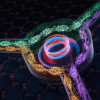⇧ [VIDÉO] You may also like this partner content
An international research team has created a new structure of light called a “chiral vortex,” marking a breakthrough in our very understanding of light-matter interactions. In particular, this structure makes it possible to more easily and precisely detect the chirality of molecules, a fundamental aspect for the development of drugs and advanced optical technologies.
The chiral vortex is distinguished by its ability to interact with chiral molecules, that is, molecules that exist in two versions (left-handed or right-handed), each a mirror image of the other. This new form of light is produced by combining two beams of light with opposite circular polarizations, creating a chiral curve that changes shape depending on its position in space. The electric field of this form of light traces a chiral curve over time, forming a vortex structure that interacts with the chiral particles in a precise and stable manner.
The implications of this discovery are vast. By enabling more precise detection of molecular chirality, the chiral vortex could improve drug development processes, where chirality plays an important role. Traditional measurements of chirality struggle to identify the concentration of right-handed and left-handed molecules in samples containing nearly equal amounts of both. With our new method, a tiny excess concentration of either mirror twin can be detected, which can be enough to change the course of a life. ” says Dr. Nicola Mayer, postdoctoral researcher at the Max Born Institute, in a press release of the university. The work, described in the journal Nature Photonicswere carried out by a team from the Max Born Institute in collaboration with King’s College London, Imperial College London and the University of Trieste (Italy).
:: THE T-SHIRT THAT SUPPORTS SCIENCE! ::
Applications in optics and medicine
The chiral vortex could be used in a variety of optical applications, from optical tweezers to nanostructure manipulation. For example, circularly polarized vortex beams can twist materials at the molecular level to form chiral nanostructures, thereby transferring the “helicity” of light to matter, including through “ direct writing » by a femtosecond laser.
Furthermore, this new form of light allows for the detection of chiral biomarkers in a faster and less invasive manner compared to traditional chemical methods. Indeed, the concept of chiral topological light exploits the global properties of vortex light and the high sensitivity of synthetic chiral light. In other words, instead of focusing on the structure of light in space, this method encodes the chirality of light in time, thus creating a chiral three-dimensional curve during a laser cycle. This allows for ultrafast and “enantiosensitive” nonlinear optical signals, i.e. sensitive to chiral molecules, with unparalleled precision.
Understanding the Chiral Vortex
This new method thus overcomes a major limitation of traditional optical beams, whose spatial scale is much larger than that of chiral molecules. By creating a synthetic chiral light source with vortex beams, researchers can now detect subtle differences between so-called “right-handed” and “left-handed” molecules, even in dilute mixtures. This opens the way to applications in the fields of chemistry, biology, and even quantum computing, where chirality can be used to encode information in quantum bits.
technology could one day increase the processing power of quantum computers by increasing the amount of data that individual “quantum bits” can carry.
See also

The robustness of the received signals against fluctuations common in laboratory chirality experiments notably prevents errors due to variations in the intensity of light in their system, which is already a very good start. The researchers now plan to further explore the potential applications of the technology.
Source : Nature Photonics
